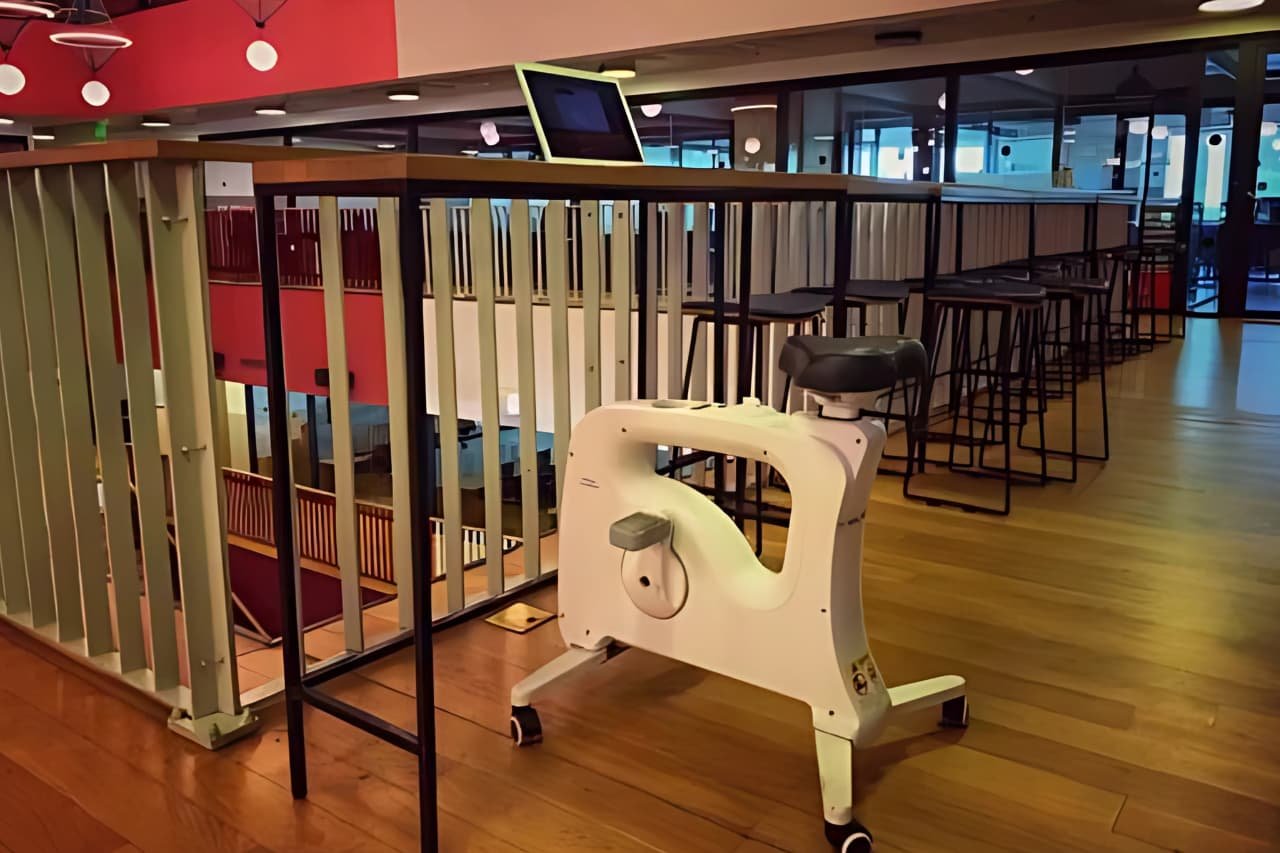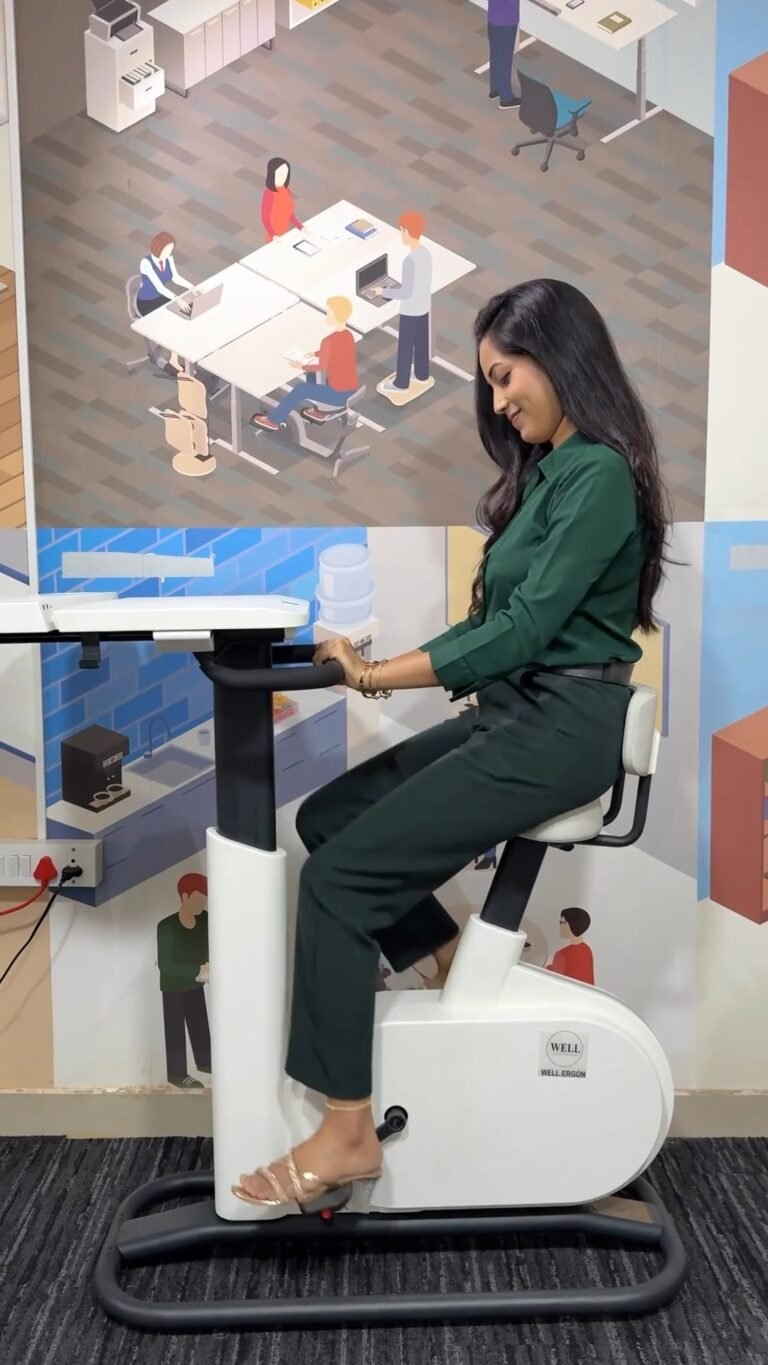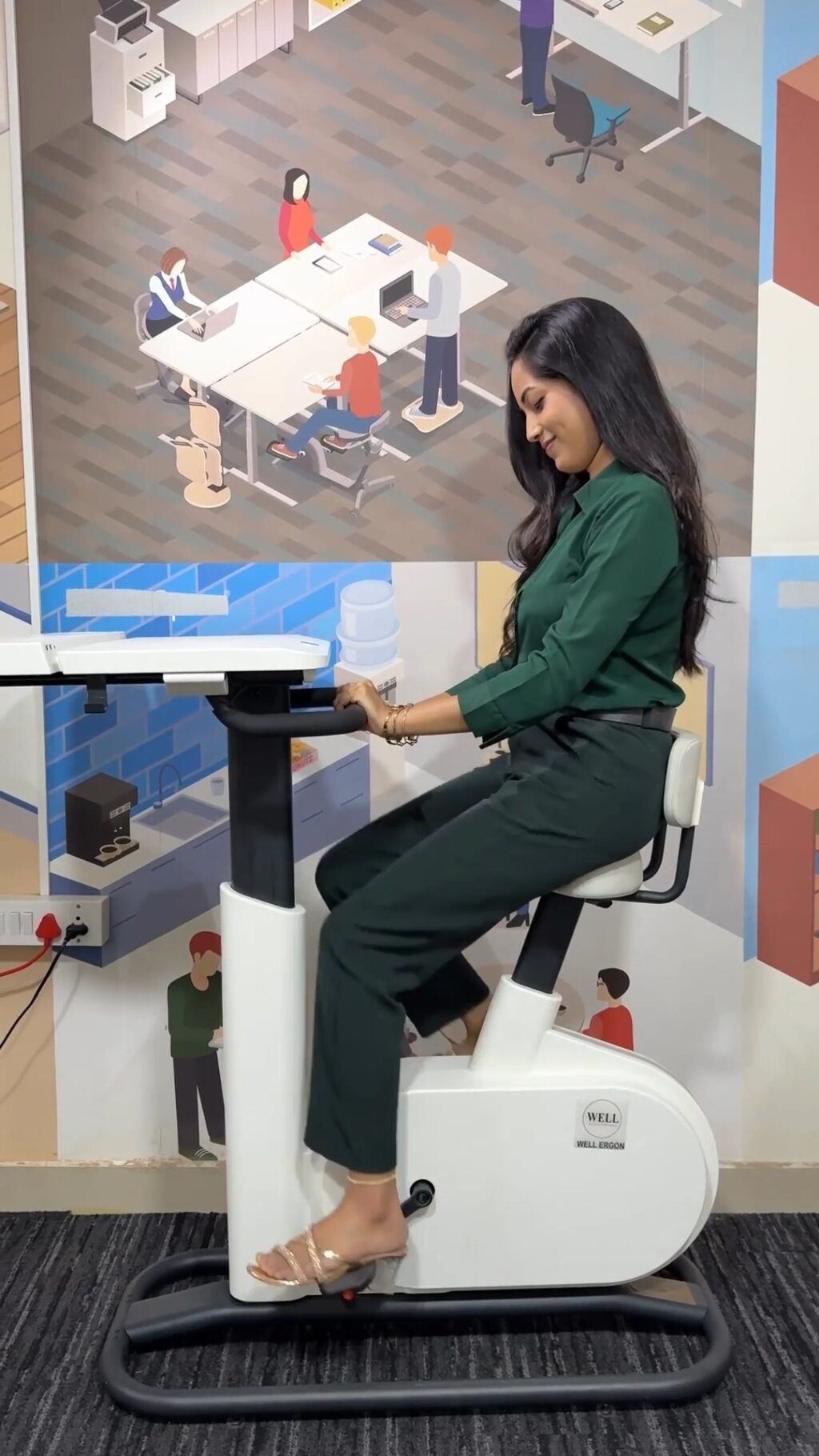Workplace wellness, driven by employers, encompasses initiatives and programs fostering employees’ physical, mental, and emotional well-being. These efforts combat workplace stress, sedentary behavior, inadequate nutrition, and lifestyle choices to cultivate a healthier, more productive work environment. Activities, including cycling machine sessions, stress management workshops, health assessments, and work-life balance enhancements, are integral to these programs. Their aim: elevate employee health, decrease absenteeism, uplift morale, and, in turn, enhance productivity and job satisfaction.
The importance of employee health and productivity cycling machine:
Employee health and productivity are closely intertwined and hold significant importance for both employees and employers. Here are key reasons why they matter:
1. Improved Employee Well-being: Prioritizing employee health ensures that workers are physically and mentally fit, reducing the risk of illness, chronic conditions, and mental health issues. This not only benefits the individual but also contributes to a higher quality of life.
2. Increased Productivity: Healthy employees tend to be more productive. They have higher energy levels, better focus, and are less likely to suffer from fatigue. This means they can complete tasks more efficiently and effectively.
3. Reduced Absenteeism: Healthy employees are less likely to take sick leave. By addressing health concerns and providing support through wellness programs, employers can reduce absenteeism rates, ensuring a consistent workforce.
4. Enhanced Job Satisfaction: A focus on employee health and well-being can boost job satisfaction. When employees feel that their employer cares about their health, they are more likely to feel valued and engaged in their work.
5. Lower Healthcare Costs: Employers often provide health insurance to their workers. By promoting health and preventing illness, employers can reduce healthcare costs associated with treating preventable conditions.
6. Attracting and Retaining Talent: A company with a robust wellness program is more attractive to potential employees. It can also aid in retaining talent, as employees are more likely to stay with an employer who supports their health and well-being.
7. Enhanced Company Culture: A focus on wellness can help create a positive company culture. Employees who feel their well-being is a priority are more likely to engage in a collaborative and supportive work environment.
8. Compliance and Legal Benefits: In some regions, there may be legal requirements or incentives for employers to provide wellness programs. Complying with these regulations can have legal and financial benefits.
9. Reputation and Brand Image: Companies that prioritize employee health and well-being often enjoy a better reputation. A positive brand image can attract customers, partners, and investors.
10. Long-Term Sustainability: Investing in employee health and productivity can contribute to the long-term success and sustainability of a company by reducing turnover, increasing efficiency, and maintaining a motivated workforce.
What Are Workplace Cycling Machine?
Workplace cycling machines:
Workplace cycling machine, also known as desk cycle machine or under-desk bikes, are stationary exercise devices designed to be used while sitting at a desk or workstation. These machines allow individuals to engage in low-impact cycling motions while working, effectively combining physical activity with daily tasks.
Workplace cycling machine typically consist of a compact, pedal-operated unit that can be placed under a desk or table. Users can sit in a regular office chair and pedal the machine with their feet, mimicking the motion of cycling. Some models may also include features like adjustable resistance levels, digital displays to track metrics like distance and calories burned, and even integrated apps for interactive workouts.
These machines are designed to provide a means of incorporating light to moderate physical activity into a sedentary work routine. They are intended to combat the negative effects of prolonged sitting, such as reduced circulation, muscle stiffness, and decreased energy levels. By allowing employees to pedal while working, workplace cycling machine aim to promote better blood flow, boost energy, and contribute to improved overall health and well-being.

The different types and variations available:
Workplace cycling machine come in various types and variations to accommodate different preferences and work environments. Here are some of the common types and variations available:
1. Under Desk Bikes: These are compact and designed to fit under a standard desk or table. Under-desk bike typically have low profiles, allowing users to pedal discreetly while working. They often come with adjustable resistance levels and digital displays to track progress.
Workplace cycling machine come in various types and variations to accommodate different preferences and work environments. Here are some of the common types and variations available:
1. Under Desk Bikes: These are compact and designed to fit under a standard desk or table. Under-desk bike typically have low profiles, allowing users to pedal discreetly while working. They often come with adjustable resistance levels and digital displays to track progress.

2. Mini Exercise Bikes: Mini exercise bikes are small, portable devices that can be placed on a desk or tabletop. They can be used for both upper and lower-body workouts. Some models can be used while seated, while others can be placed on a table for arm exercises.
3. Standing Desk Cycles: These machines are designed for use with standing desks. They come with adjustable heights to match the desk’s height. Users can cycle while working in a standing position, promoting better posture and ergonomics.
4. Recumbent Desk Cycles: These are similar to traditional recumbent exercise bikes but designed for office use. They have a comfortable, reclined seating position and a backrest, making them suitable for extended periods of pedaling.
5. Integrated Desk Cycle Workstations: Some companies offer integrated workstation setups that combine a desk or tabletop with a built-in cycling machine. This allows users to work while cycling without needing to switch between separate pieces of furniture.
6. Smart and Connected Cycling Machines: Many modern workplace cycling machines are equipped with Bluetooth connectivity and mobile apps. Users can track their exercise data, participate in virtual workouts, and sync their progress with health and fitness apps.
7. Foldable and Portable Options: Some workplace cycling machines are designed to be easily folded or disassembled for convenient storage or transportation. This feature is useful for individuals who need to move their cycling machine between different work locations.
8. Ergonomic Features: High-end models may include ergonomic features such as adjustable seat height, cushioned seats, and adjustable pedal resistance to cater to individual comfort levels and preferences.
9. Quiet Operation: Noise levels can be a concern in shared workspaces. Some workplace cycling machines are designed for quiet operation, ensuring that users can exercise without disturbing colleagues.
10. Customization Options: Certain manufacturers offer customization options, allowing users to choose colors, materials, and accessories to match their workspace aesthetics and personal preferences.
11. Cycle Station EB-03: The Cycle Station EB-03 is a desk exercise bike that allows you to get a workout in while you work. It is a sturdy and durable bike that can support a maximum user weight of 400 lbs. The bike has an ergonomic seat with a backrest that provides comfort for long periods of use. The pedals are oversized and can be pedaled in both forward and backward directions. The bike also has a non-adjustable Eddy current brake system that provides smooth and quiet operation.
When choosing a workplace cycling Chair machine, individuals and organizations should consider factors like available space, desired features, budget, and the specific needs of users to select the most suitable type and variation.
How cycling machine can be integrated into office spaces?
Integrating workplace cycling machines into office spaces requires thoughtful planning and consideration of the workspace layout, employee preferences, and the overall office environment. Here’s how these machines can be effectively integrated:
1. Determine the Ideal Location:
Identify suitable locations within the office where employees can use the cycling machines comfortably. These locations should offer enough space for users to pedal without obstruction.
Consider areas with natural light and good ventilation to create a pleasant environment for cycling.
2. Choose Appropriate Models:
Select workplace cycling machines that align with the available space and the preferences of employees. Compact under desk bike are ideal for individual workstations, while larger models may be placed in common areas.
3. Create Dedicated Exercise Spaces:
Designate specific zones within the office as exercise or wellness areas. These spaces can house multiple cycling machine, yoga mats, fitness balls, and other wellness equipment.
Decorate these areas with motivating and calming elements to encourage employees to use them regularly.
4. Incorporate Standing Desks:
Pair standing desks with standing desk cycles to encourage physical activity while working in a standing position.
Ensure that the cycling machine’s height is adjustable to match the height of the standing desk.
5. Implement a Rotation Schedule:
If space is limited, consider implementing a rotation schedule where employees can book time slots to use the cycling machines.
Keep track of reservations using a scheduling system to ensure fair access.
6. Offer Incentives and Challenges:
Promote the use of workplace cycling machines by introducing incentives, such as rewards or recognition for employees who consistently use them.
Organize friendly challenges or competitions to create excitement and motivate participation.
7. Provide Comfortable Seating:
Ensure that the chairs and seating arrangements in areas with cycling machines are comfortable and ergonomic. This allows employees to switch between cycling and desk work seamlessly.
8. Noise Considerations:
Be mindful of noise levels in shared office spaces. Opt for quieter cycling machines or designate quieter areas for their use to avoid disturbing colleagues.
9. Educate Employees:
Offer training or informational sessions on how to use the cycling machines correctly to maximize their benefits and prevent any safety concerns.
Provide resources and guidance on incorporating cycling into daily routines.
10. Regular Maintenance:
Implement a maintenance schedule to keep the machines in good working condition. Regular maintenance ensures that they remain safe and functional.
11. Promote a Wellness Culture:
Foster a workplace culture that encourages physical activity and overall wellness. Leadership and management can set an example by using machines and prioritizing employee well-being.
12Feedback and Adaptation:
Solicit feedback from employees regarding the placement and usage of the cycling machines. Make adjustments based on their input to improve the experience.
13. Monitoring and Tracking:
Use tracking tools and software to monitor the usage of workplace cycling machines. Analyze the data to evaluate the impact on employee well-being and productivity.
Integrating workplace cycling machines into office spaces requires a holistic approach that considers both physical and cultural aspects of the workplace.
Benefits of Workplace Cycling Machine
Physical Benefits:
Cycling machines are excellent tools for promoting physical wellness, offering a range of benefits for individuals of various fitness levels. Here’s how cycling machines contribute to physical wellness:
1. Cardiovascular Health: Cycling on these machines elevates the heart rate, effectively serving as a cardiovascular workout. Regular use can improve heart and lung function, enhance circulation, and reduce the risk of cardiovascular diseases like heart disease and stroke.
2. Weight Management: Cycling machines provide an efficient way to burn calories. Regular use helps with weight management by increasing calorie expenditure, making it easier to maintain a healthy weight or achieve weight loss goals.
3. Muscle Tone: Cycling engages various muscle groups, including the quadriceps, hamstrings, calves, and glutes. Over time, this can lead to improved muscle tone and overall strength, particularly in the lower body.
4. Low-Impact Exercise: Cycling is a low-impact exercise, which means it puts less stress on the joints compared to activities like running. This makes it an excellent choice for individuals with joint issues, arthritis, or those recovering from injuries.
5. Improved Endurance: Regular cycling on these machines can boost endurance levels. This improved stamina allows individuals to engage in physical activities with less fatigue and for longer durations.
6. Better Coordination and Balance: Cycling machines help improve coordination and balance, as users need to maintain a steady pedaling rhythm while staying balanced on the machine. This can be particularly beneficial for older adults.
7. Joint Flexibility: The fluid pedaling motion of cycling helps promote joint flexibility, especially in the hips and knees. This can be beneficial for maintaining joint health and preventing stiffness.
8. Bone Density: Weight-bearing exercises like cycling can contribute to increased bone density, reducing the risk of osteoporosis and fractures, particularly in postmenopausal women.
9. Stress Reduction: Physical activity, including cycling, triggers the release of endorphins, which are natural mood lifters. Regular exercise helps reduce stress and improve overall mental well-being.
10. Sleep Quality: Engaging in physical activity like cycling can lead to better sleep patterns and improved sleep quality, which is essential for overall health and wellness.
11. Disease Prevention: Regular physical activity, including cycling, is associated with a reduced risk of chronic diseases such as type 2 diabetes, certain types of cancer, and metabolic disorders.
12. Longevity: Maintaining physical wellness through activities like cycling can contribute to a longer, healthier life by reducing the risk of premature mortality.
13. Customizable Intensity: Most cycling machines allow users to adjust the resistance level, making it suitable for individuals of all fitness levels, from beginners to advanced athletes.
14. Consistency: Unlike outdoor cycling, workplace cycling machines offer the advantage of consistency. Users can exercise regardless of weather conditions or time constraints.
Incorporating cycling machines into a fitness routine or workplace environment provides a convenient and effective way to enhance physical wellness. Regular use can lead to numerous health benefits, from cardiovascular improvements to increased strength and flexibility, ultimately contributing to an overall healthier and more active lifestyle.
Mental Health Benefits:
Cycling machines can have a positive impact on mental well-being in several ways, contributing to improved mood, reduced stress, and enhanced overall mental health. Here are some ways in which cycling machines can positively affect mental well-being:
1. Stress Reduction:
- Release of Endorphins: Exercise, including cycling, triggers the release of endorphins, which are natural mood lifters. These endorphins help reduce stress and promote a sense of well-being.
- Cortisol Regulation: Physical activity can help regulate the body’s stress hormone, cortisol. Regular exercise on cycling machine can lead to lower cortisol levels, reducing the negative effects of chronic stress.
2. Improved Mood:
- Enhanced Brain Function: Cycling increases blood flow to the brain, which can lead to improved cognitive function and enhanced mood. It can help individuals feel more alert and focused.
- Reduced Symptoms of Depression: Regular exercise, including cycling, has been shown to reduce symptoms of depression and anxiety. It can be an effective complementary therapy for individuals dealing with mood disorders.
3. Better Sleep:
- Regulated Sleep Patterns: Engaging in physical activity like cycling can help regulate sleep patterns. Regular exercise is associated with improved sleep quality and can help individuals fall asleep faster and enjoy deeper, more restorative sleep.
- Stress Reduction: Cycling machines can help individuals manage stress, making it easier to relax and unwind before bedtime, further improving sleep quality.
4. Enhanced Self-Esteem:
- Achievement and Goals: Setting and achieving exercise goals on cycling machines can boost self-esteem and self-confidence. The sense of accomplishment from reaching fitness milestones can have a positive impact on mental well-being.
- Body Image: Regular exercise and the physical benefits it brings, such as muscle toning and weight management, can improve body image perception and lead to greater self-acceptance.
5. Increased Energy Levels:
- Boosted Energy: Cycling machines can increase energy levels, making individuals feel more invigorated and motivated throughout the day. This can positively affect mental alertness and productivity.
- Reduced Fatigue: Exercise, even in moderate amounts, can reduce feelings of fatigue and lethargy, enhancing overall mental vitality.
6. Stress Coping Mechanism:
- Healthy Coping Strategy: Cycling can serve as a healthy and constructive way to cope with daily stressors. Engaging in physical activity allows individuals to clear their minds and gain a fresh perspective on challenges.
7. Social Interaction:
- Community Engagement: In some cases, workplace or gym-based cycling machines can provide opportunities for social interaction. Sharing a workout space or participating in group classes can foster a sense of community, reducing feelings of isolation and promoting mental well-being.
8. Mind-Body Connection:
- Mindfulness: Cycling can be a form of mindfulness exercise, allowing individuals to focus on the present moment, their breathing, and the rhythm of their pedaling. This meditative quality can reduce mental clutter and promote relaxation.
It’s important to note that the mental health benefits of cycling machines are often more pronounced when exercise is part of a well-rounded approach to mental well-being. Combining regular physical activity with other stress-reduction strategies, such as meditation, relaxation techniques, and seeking support from mental health professionals when needed, can lead to even greater improvements in mental health and well-being.
Productivity and Engagement:
Workplace cycling machine can significantly boost productivity in various ways, making them a valuable addition to any office setting. Here are the key ways in which these machines can enhance productivity:
1. Increased Energy Levels: Cycling machine provide a quick and convenient way for employees to get their blood flowing and increase their energy levels. Short cycling breaks throughout the day can help combat the midday slump and keep employees feeling alert and focused.
2. Enhanced Concentration: Physical activity, such as cycling, stimulates the release of neurotransmitters like dopamine and norepinephrine, which are associated with improved concentration and cognitive function. Regular use of cycling machine can enhance employees’ ability to stay focused on tasks.
3. Stress Reduction: Cycling promotes the release of endorphins, which are natural mood elevators. Reduced stress levels contribute to a more relaxed and productive work environment, as employees are better equipped to handle challenges without feeling overwhelmed.
4. Mental Clarity: Engaging in light exercise on a cycling machine can clear the mind and improve mental clarity. It can help employees think more clearly, make decisions more efficiently, and solve problems with greater ease.
5. Improved Mood: Regular exercise, including cycling, has been shown to have a positive impact on mood. Happier employees are generally more engaged, cooperative, and motivated, which can lead to increased productivity.
6. Enhanced Physical Health: Workplace cycling machines help combat the negative effects of prolonged sitting, which can include stiffness, discomfort, and reduced blood circulation. By promoting better physical health, these machines can help prevent health-related distractions that can hinder productivity.
7. Short Breaks for Physical Activity: Incorporating short cycling breaks into the workday encourages employees to step away from their desks and screens periodically. These breaks can act as a mental reset and prevent burnout, ultimately boosting productivity when they return to work.
8. Productive Breaks: Instead of traditional sedentary breaks, employees can use cycling machines during their downtime. This allows them to engage in physical activity while still having the opportunity to check emails, read documents, or take calls.
9. Team Building: Some organizations use workplace cycling machines as a team-building activity. Employees can engage in friendly competitions or group workouts, fostering camaraderie and positive relationships among colleagues, which can translate into better teamwork and productivity.
10. Encouraging Movement: The presence of cycling machines in the workplace serves as a visual reminder to employees to prioritize movement. This can lead to increased use of stairs, walking meetings, and other forms of physical activity throughout the day.
11. Boosting Employee Morale: Providing employees with access to workplace cycling machines demonstrates that the organization values their well-being. This can boost morale and create a positive work culture, leading to higher job satisfaction and, in turn, increased productivity.
12. Long-Term Health Benefits: Over time, regular use of cycling machines can contribute to better physical health, reducing the likelihood of sick days and absenteeism. Healthy employees are more likely to be consistently present and productive.
To maximize the productivity-boosting benefits of workplace cycling machines, organizations should encourage their use, provide guidance on incorporating short cycling breaks, and ensure that employees have easy access to these machines in comfortable and ergonomically sound settings.
Community and Collaboration:
Cycling machines can foster a sense of community within a workplace or fitness environment by providing a shared space for employees or gym-goers to engage in physical activity together. Here’s how cycling machines can contribute to building a sense of community:
1. Shared Activity: Cycling machines offer a common fitness activity that individuals can participate in simultaneously. This shared experience creates a sense of camaraderie among users, as they engage in the same physical pursuit.
2. Group Workouts: Some fitness facilities or workplaces organize group cycling classes or challenges using the available cycling machines. Group workouts encourage participants to support and motivate each other, enhancing the sense of community.
3. Friendly Competition: Cycling machines with digital displays often include features that allow users to compete with each other virtually, either in real-time or by setting goals. Friendly competition can foster a sense of community as participants strive to outperform one another.
4. Social Interaction: While using cycling machines, individuals have the opportunity for social interaction. They can engage in conversations, share fitness tips, or simply exchange friendly greetings, creating a more sociable workout environment.
5. Supportive Environment: A sense of community can provide emotional support and encouragement during workouts. Knowing that others are sharing the same fitness journey can motivate individuals to stay committed to their exercise routines.
6. Mutual Goals: Cycling machine can be used by individuals with varying fitness levels and goals. However, the common goal of improving health and well-being unites users, fostering a sense of shared purpose.
7. Wellness Programs: Employers often incorporate cycling machine into workplace wellness programs. These programs can include challenges or incentives for employees to use the machines regularly, promoting a culture of health and well-being that strengthens the workplace community.
8. Team-Building Activities: Some organizations use cycling machine as part of team-building activities or events. Teams or departments may compete in cycling challenges, promoting team cohesion and friendly rivalry.
9. Supportive Communities: In some fitness centers or gyms, cycling enthusiasts form their own supportive communities or clubs. These groups provide a sense of belonging and offer opportunities for group rides and social events.
10. Knowledge Sharing: Experienced users of cycling machines may share their expertise and tips with newcomers, creating a supportive learning environment.
11. Diversity and Inclusion: Cycling machines can be used by people of various fitness levels, ages, and backgrounds. This inclusivity can contribute to a more diverse and welcoming fitness community.
12. Celebrating Achievements: Achieving fitness milestones, such as completing a certain distance or burning a specific number of calories, can be celebrated collectively, reinforcing the sense of community and accomplishment.
13. Positive Peer Pressure: Being surrounded by others who are actively engaging in exercise can create a form of positive peer pressure. Individuals may feel more motivated to stay on track with their fitness goals in the company of others.
Overall, cycling machines provide a platform for people to come together, share experiences, and support each other on their fitness journeys. This sense of community can make the exercise environment more enjoyable, motivating, and inclusive, ultimately encouraging regular physical activity and overall well-being.
Conclusion
The blog discusses the positive impact of workplace cycling machine on employee well-being, productivity, and community building. It highlights the importance of addressing health challenges faced by employees and introduces the concept of workplace wellness. The challenges of modern work environments and their impact on employee health and productivity are explored.
The blog then delves into the specific focus on workplace cycling machine. It explains what workplace cycling machine are and their variations, emphasizing how they can be integrated into office spaces to promote physical wellness and enhance employee health. The benefits of cycling machines are examined in detail, including their positive effects on cardiovascular health, weight management, muscle toning, and mental well-being.
Furthermore, the blog underscores the need for innovative solutions to tackle these challenges effectively. It explains how workplace cycling machine contribute to mental well-being by reducing stress, improving mood, and fostering a sense of community. Lastly, the blog discusses how these machines can foster a sense of community by providing shared activities, group workouts, and friendly competition, thereby promoting a supportive and inclusive environment.
In conclusion, workplace cycling machines offer a multifaceted approach to improving employee health, mental well-being, productivity, and community engagement. By addressing physical and mental wellness, these machines contribute to creating a more balanced and thriving workplace environment.
Dear Business Leaders,
It’s time to consider a small but transformative change for your workplace—incorporating cycling machines. These machines offer a myriad of benefits not only to your employees but also to your company’s overall productivity and well-being. Here’s why you should make this investment:
Employee Health and Wellness: Prioritizing your employees’ well-being should be a top concern. Cycling machines can help employees stay physically active even during their busy workdays. This contributes to improved cardiovascular health, muscle tone, and weight management.
Enhanced Productivity: Healthy employees are more productive. By providing access to cycling machines, you’re investing in a workforce that’s energized, focused, and better equipped to tackle tasks efficiently.
Stress Reduction: The workplace can be stressful, but cycling machines offer an effective stress-relief outlet. Regular exercise on these machines can reduce stress levels, leading to a calmer and more composed team.
Mental Well-Being: In today’s fast-paced world, mental well-being is paramount. Cycling machines can positively impact mental health by boosting mood, enhancing cognitive function, and fostering a sense of accomplishment.
Team Building: Group workouts and challenges on cycling machines can promote teamwork and a sense of community among your employees. A united team is often a more productive one.
Inclusivity and Diversity: Cycling machines are accessible to individuals of various fitness levels and backgrounds. This inclusivity fosters diversity in your wellness initiatives and promotes a culture of belonging.
Attraction and Retention of Talent: Companies that prioritize employee well-being are more attractive to top talent. Moreover, satisfied and healthy employees are more likely to stay with your organization, reducing turnover costs.
Innovation and Adaptability: Embracing innovative solutions like cycling machines demonstrates your commitment to adapting to the changing needs of your workforce. It positions your business as forward-thinking and agile.
Long-Term Savings: Investing in employee health and well-being can result in long-term cost savings. Healthier employees mean fewer sick days, reduced healthcare expenses, and higher productivity.
Competitive Edge: By providing cycling machines and fostering a wellness-focused culture, you differentiate your business in the marketplace. This can attract customers who appreciate socially responsible and health-conscious organizations.
So, don’t wait any longer. Consider incorporating cycling machine into your workplace. Create an environment where your employees can thrive physically and mentally. The benefits are not only measurable but also invaluable in building a stronger, healthier, and more productive workforce.
Invest in cycling machines, and invest in your employees’ well-being and the future success of your business.
Sincerely,
VIJAY KUMAR VARANASI
Founder
WELL ERGON















